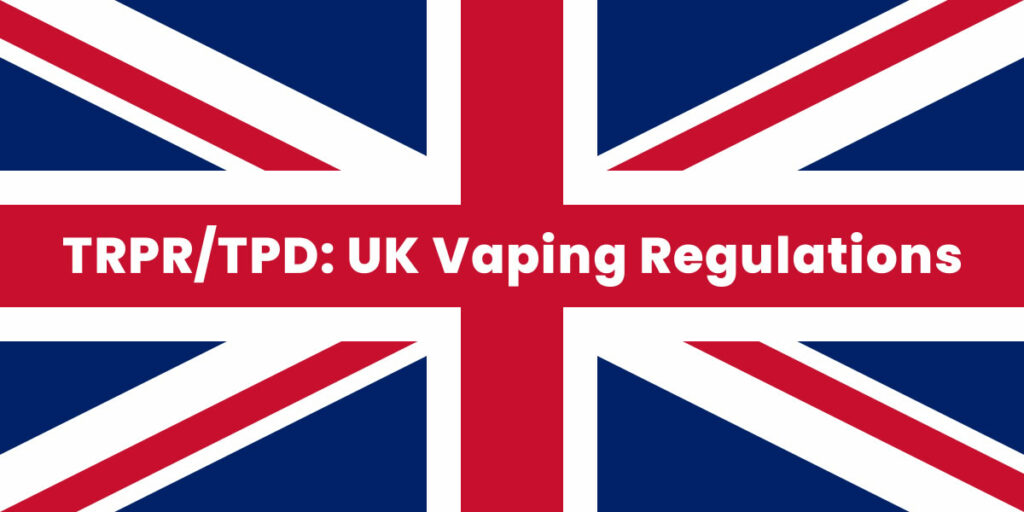In May 2017, the UK implemented new vaping regulations known as the Tobacco and Related Products Regulations (TRPR). This interpreted the European Union’s Tobacco Products Directive (TPD) into British law.
The TPD was introduced in 2016 to regulate tobacco products across the EU. It has since been revised to include vaping devices and e-liquids containing nicotine.
The TRPR established new mandatory requirements for vaping products sold in the UK after May 20, 2017. Here is an overview of the key regulations and how they impact vapers.
Summary of the TRPR Vaping Regulations
In the name of public safety, the TRPR placed major new constraints on vaping. These include:
- Tank size limited to 2ml maximum – Previously tanks ranged from 2ml up to 10ml or more. Now 2ml is the legal limit.
- E-liquid bottles max 10ml – Bulk e-liquid could previously be sold in large bottles. Now 10ml is the maximum size bottle permitted.
- Max nicotine strength 20mg/ml – The legal limit for nicotine strength is capped at 20mg/ml (2%). Higher concentrations like 24mg/ml can no longer be sold.
- Health warnings required – Packaging must contain specific health warnings about nicotine addiction.
- Leakproof filling system – Bottles must have a secure leakproof method for filling tanks.
- Emissions testing – Manufacturers must test emissions and provide toxicology reports.
- Advertising restrictions – Vaping promotions and advertising will face significant restrictions.
- Product notification – All vaping products must be registered with the MHRA, which will regulate this sector.
The official UK government TRPR document
By bringing vaping products under the regulatory umbrella, the TRPR aims to ensure safety and consistency across the emerging market. But reaction from consumers and the industry has been mixed.
How the MHRA Enforces the TRPR
The Medicines and Healthcare products Regulatory Agency (MHRA) is the body overseeing and enforcing the TRPR regulations in the UK.
For vaping products to remain on sale, vape manufacturers must submit notifications to the MHRA providing emissions testing results, health warnings, ingredients lists, toxicology data and other details.
The MHRA reviews submissions to ensure vaping products meet quality and safety standards for public health. Non-compliant products cannot legally be marketed or sold in the UK.
How the Regulations Affected the Industry and Vapers
While motivated by laudable public health interests, some TRPR rules enact noticeable changes to aspects of vaping many users had grown accustomed to:
- Smaller Tank Sizes – Reducing maximum capacity to just 2mL makes frequent refilling necessary, especially for high-wattage devices.
- Restricted Nicotine Options – The 20mg/mL cap limits choices for some accustomed to using higher concentration liquids.
- 10mL Bottle Limit – Purchasing in bulk becomes impractical due to inability to buy containers greater than 10mL.
- Reduced Marketing Exposure – Information on vaping reaches fewer smokers looking to transition off combustibles.
- Potential Price Increases – Testing and compliance costs incurred by manufacturers may drive up prices.
On the other hand, the regulations also provide some clear benefits in terms of safety assurances and reducing youth appeal:
- Child-Resistant Bottles – Tamper-proof seals help prevent accidental exposure or ingestion.
- Regulated Manufacturing – Oversight promotes quality control and reduces contaminant risks.
- Banning Certain Ads – Curbing marketing clearly aimed at youth discourages underage uptake.
- Health Warning Labels – Cautions help inform consumers about risks like nicotine addiction.
Still, vapers argue some rules feel counterproductive, unduly limiting aspects of the experience that fueled switching away from riskier combustibles. Ongoing debate continues around how to strike the right balance.
Ongoing Debate Over the Regulations
The vaping industry supports proper regulation to ensure product safety. However, debate continues over which TRPR rules are beneficial versus excessive.
For example, requirements like testing and childproof bottles seem reasonable. But limiting tank and bottle sizes, nicotine strength, and advertising appear counterproductive to industry growth and reducing smoking rates.
The regulations aim to guarantee consumer safety and quality standards. But some rules were implemented without sufficient knowledge of real-world vaping products and habits.
As a result, responsible vaping advocates continue pressing for more practical, evidence-based regulation. The goal is maximizing smoking cessation and public health benefits, not hindering access and consumer choice.
The Future of Vaping Regulations
While the TPD outlined Europe-wide vaping rules, the UK has now left the EU. This means potential for the UK to adjust regulations to better suit domestic needs.
Groups like the UK Vaping Industry Association (UKVIA) are lobbying the government for reform. Suggested changes include allowing larger tank sizes, higher nicotine concentrations, bulk e-liquid purchases and more flexible advertising to adult smokers.
With vaping’s health impacts still being researched, new evidence may compel modifying the regulations to find the right balance.
The TRPR established the first comprehensive vaping regulations in the UK. And through ongoing debate and evaluation, we can hope to arrive at practical standards that maximize smoking cessation while ensuring acceptable safety.
- Nebraska Vape Registry Law Forces Removal of Popular Brands - January 5, 2026
- Kentucky Vape & Tobacco Retailer License Deadline Jan 1 - January 3, 2026
- Washington State Nicotine Tax to Double Vape Prices - January 3, 2026


